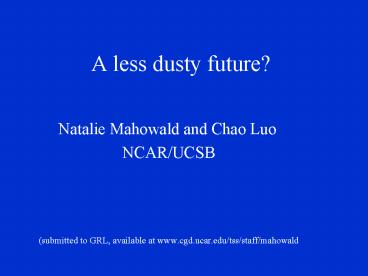A less dusty future - PowerPoint PPT Presentation
1 / 11
Title:
A less dusty future
Description:
Glacial/interglacial cycle 3- fold higher deposition globally in LGM, 10 ... Matthews [1984] land use dataset ('cultivation' includes pasturization) (CULT) ... – PowerPoint PPT presentation
Number of Views:50
Avg rating:3.0/5.0
Title: A less dusty future
1
A less dusty future?
- Natalie Mahowald and Chao Luo
- NCAR/UCSB
- (submitted to GRL, available at
www.cgd.ucar.edu/tss/staff/mahowald
2
Mineral aerosols highly variable with climate
- Glacial/interglacial cycle 3- fold higher
deposition globally in LGM, 10-100x regionally
- 1960s/1980s Barbados 4x change
Data courtesy of J. Prospero and D. Savoie
Mahowald et al., 1999
3
Atmospheric mineral aerosols/desert dust
- Source unvegetated dry soils with easily
erodible soils and strong winds - Sink
- wet deposition (precipitation scavenging)
- dry deposition (gravitational and turbulent
settling)
4
Mechanisms for variability in desert dust?
- Glacial/interglacial
- Changes in precipitation in arid source regions
- Changes in precipitation along transport pathways
e.g. Yung et al., 1996 - Changes in transport pathways
- Changes in CO2 levels in arid source regions
impacting vegetation Mahowald et al., 1999 50
of source area/loading impacted - Changes in surface winds in source regions (e.g.
Rea, 1994 not found in Mahowald et al., 1999) - 1960s/1980s in Barbados/North Atlantic
- Changes in Precipitation in Sahel e.g. Prospero
and Nees, 1986 - Resulting changes in sources in Sahel
- Changes in transport associated with precip
changes? - Human land use? e.g. Prospero and Nees, 1986
Mahowald et al., 2002
5
Role of humans
- Anthropogenic source of dust?
- In situ studies in US (e.g.) Gillette, 1988
- 50 due to disturbed (natural and anthropogenic)
sources postulated by Tegen and Fung 1995 (but
model dependent result) - Prospero et al., 2002 Goudie and Middle, 2001,
Ginoux et al., 2001 claim sources only natural
using TOMS AI, geomorphic arguments and model - Mahowald et al., 2002 Luo et al., 2003 Mahowald
et al., 2003 suggest that TOMS AI cannot
distinguish between anthropogenic and natural
sources - Could be 0-50 of current source???
- Importance of CO2 fertilization?
6
Past/present/future study
- CSM1.0 output archive meteorology and input into
MATCH/DEAD simulation Zender et al., 2003
Mahowald et al., 2002 Luo et al., 2003 Mahowald
et al., 2003 - 1880s, 1990s and 2090s simulated
- 6 different scenarios
- Time independent source (TIMIND) Ginoux et al.,
2001 - Topographic lowsvegetation changes (BASE)
- Topographic lows vegetation changes with CO2
fertilization (BASE-CO2) - 3 above 50 cultivation in desert source
(following Mahowald et al., 2002 Luo et al.,
2003) desert region Matthews 1984 land use
dataset (cultivation includes pasturization)
(CULT) - Assume no cultivation in desert in 1880s, similar
cultivation in arid regions in 2090s (based on
IMAGES1.0 model Alcamo, 1994)
7
- Source areas increase or decrease between 1880s
and 1990s, depending on assumptions - Source areas decrease between present and 2090s
- Model is driest during 1990s in desert regions
(model/simulation dependent)
8
Source/Deposition
- Source magnitude increase or decrease between
1880s and 1990s, depending on assumptions - Source magnitude decrease between present and
2090s - Model source strongest in 1880s, 1980s then
2090s for TIMIND
9
- Atmospheric loading sourcelifetime
- Lifetime relatively stable between climates
- Loading increase or decrease between 1880s and
1990s, depending on assumptions - Loading decreases between present and 2090s
10
Comparison with ice core data for preindustrial/
current climate (use ratio of deposition or
concentration for comparison)
- None of the scenarios does appreciably better or
worse than others - Ice cores may not be located in right place to
sample - Ice cores give regionally inconsistent signals
11
Summary/conclusions
- Current climate anthropogenic dust (including
climate impacts) up to 60 or humans caused
decrease of 20 - Future dust 20-60 lower than current climate
- Sensitive to model simulations (20 level
herecould be different with other
model/simulations) - Sensitive to scenario (role of CO2 fertilization
or land use) 50 level - Could have profound impact on ocean CO2 uptake,
radiative forcing, indirect forcing, atmospheric
chemistry, terrestrial biosphere - Natural Aerosol likely to vary strongly with
climate change































